Gabriella A. B. Barros
modl.ai
Human-like Bots for Tactical Shooters Using Compute-Efficient Sensors
Dec 30, 2024Abstract:Artificial intelligence (AI) has enabled agents to master complex video games, from first-person shooters like Counter-Strike to real-time strategy games such as StarCraft II and racing games like Gran Turismo. While these achievements are notable, applying these AI methods in commercial video game production remains challenging due to computational constraints. In commercial scenarios, the majority of computational resources are allocated to 3D rendering, leaving limited capacity for AI methods, which often demand high computational power, particularly those relying on pixel-based sensors. Moreover, the gaming industry prioritizes creating human-like behavior in AI agents to enhance player experience, unlike academic models that focus on maximizing game performance. This paper introduces a novel methodology for training neural networks via imitation learning to play a complex, commercial-standard, VALORANT-like 2v2 tactical shooter game, requiring only modest CPU hardware during inference. Our approach leverages an innovative, pixel-free perception architecture using a small set of ray-cast sensors, which capture essential spatial information efficiently. These sensors allow AI to perform competently without the computational overhead of traditional methods. Models are trained to mimic human behavior using supervised learning on human trajectory data, resulting in realistic and engaging AI agents. Human evaluation tests confirm that our AI agents provide human-like gameplay experiences while operating efficiently under computational constraints. This offers a significant advancement in AI model development for tactical shooter games and possibly other genres.
Automatic Critical Mechanic Discovery in Video Games
Sep 06, 2019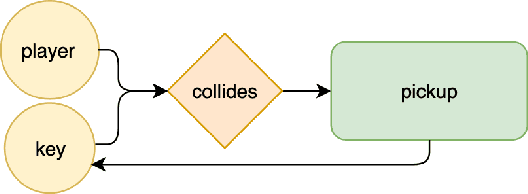

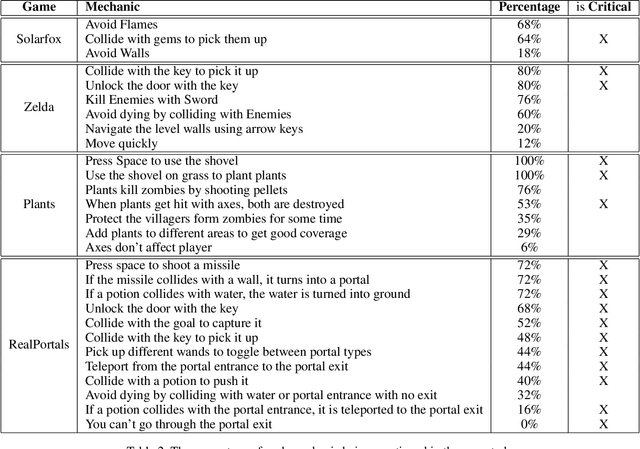
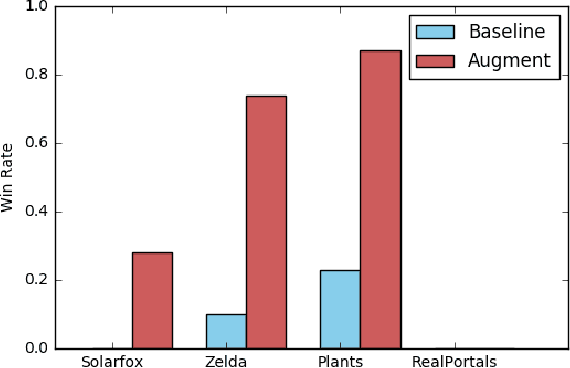
Abstract:We present a system that automatically discovers critical mechanics in a variety of video games within the General Video Game Artificial Intelligence (GVG-AI) framework using a combination of game description parsing and playtrace information. Critical mechanics are defined as the mechanics most necessary to trigger in order to perform well in the game. In a user study, human-identified mechanics are compared against system-identified mechanics to verify alignment between humans and the system. The results of the study demonstrate that our method is able to match humans with high consistency. Our system is further validated by comparing MCTS agents augmented with critical mechanic information against baseline MCTS agents on 4 games in GVG-AI. The augmented agents show a significant performance improvement over their baseline counterparts for all 4 tested games, demonstrating that knowledge of system-identified mechanics are responsible for improved performance.
Generating Levels That Teach Mechanics
Oct 01, 2018



Abstract:The automatic generation of game tutorials is a challenging AI problem. While it is possible to generate annotations and instructions that explain to the player how the game is played, this paper focuses on generating a gameplay experience that introduces the player to a game mechanic. It evolves small levels for the Mario AI Framework that can only be beaten by an agent that knows how to perform specific actions in the game. It uses variations of a perfect A* agent that are limited in various ways, such as not being able to jump high or see enemies, to test how failing to do certain actions can stop the player from beating the level.
DATA Agent
Sep 28, 2018



Abstract:This paper introduces DATA Agent, a system which creates murder mystery adventures from open data. In the game, the player takes on the role of a detective tasked with finding the culprit of a murder. All characters, places, and items in DATA Agent games are generated using open data as source content. The paper discusses the general game design and user interface of DATA Agent, and provides details on the generative algorithms which transform linked data into different game objects. Findings from a user study with 30 participants playing through two games of DATA Agent show that the game is easy and fun to play, and that the mysteries it generates are straightforward to solve.
* 8 pages, 4 images, 3 tables
AtDelfi: Automatically Designing Legible, Full Instructions For Games
Sep 17, 2018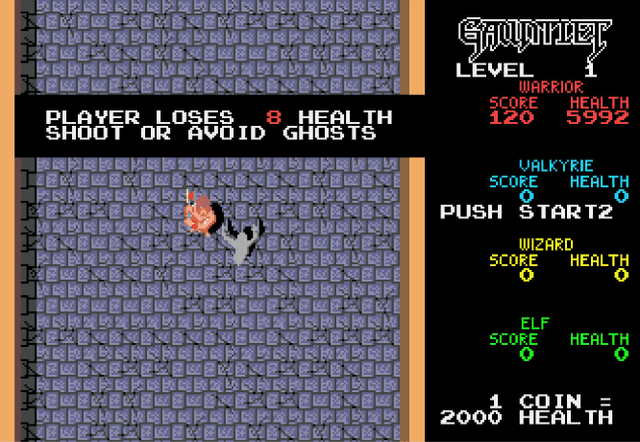
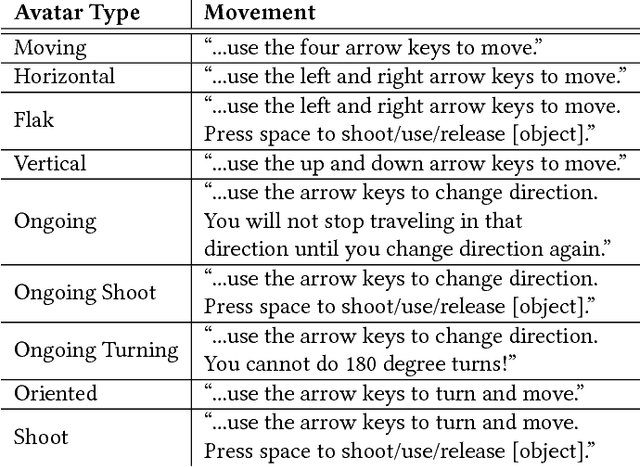
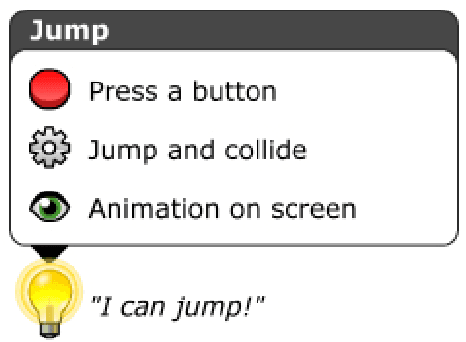
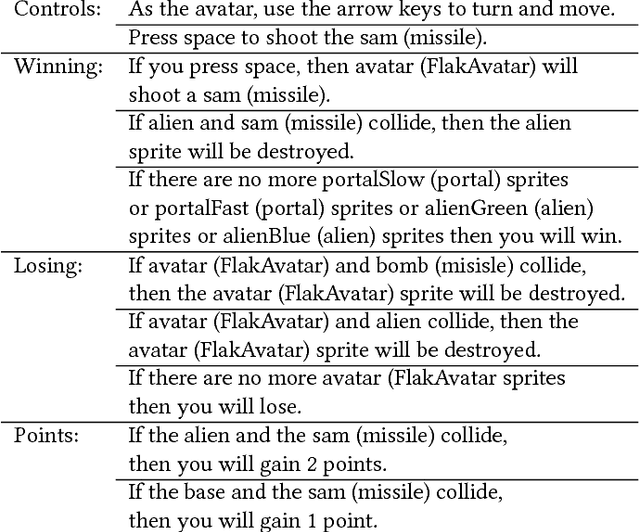
Abstract:This paper introduces a fully automatic method for generating video game tutorials. The AtDELFI system (AuTomatically DEsigning Legible, Full Instructions for games) was created to investigate procedural generation of instructions that teach players how to play video games. We present a representation of game rules and mechanics using a graph system as well as a tutorial generation method that uses said graph representation. We demonstrate the concept by testing it on games within the General Video Game Artificial Intelligence (GVG-AI) framework; the paper discusses tutorials generated for eight different games. Our findings suggest that a graph representation scheme works well for simple arcade style games such as Space Invaders and Pacman, but it appears that tutorials for more complex games might require higher-level understanding of the game than just single mechanics.
* 10 pages, 11 figures, published at Foundations of Digital Games Conference 2018
"Press Space to Fire": Automatic Video Game Tutorial Generation
May 30, 2018



Abstract:We propose the problem of tutorial generation for games, i.e. to generate tutorials which can teach players to play games, as an AI problem. This problem can be approached in several ways, including generating natural language descriptions of game rules, generating instructive game levels, and generating demonstrations of how to play a game using agents that play in a human-like manner. We further argue that the General Video Game AI framework provides a useful testbed for addressing this problem.
Data-driven Design: A Case for Maximalist Game Design
May 30, 2018

Abstract:Maximalism in art refers to drawing on and combining multiple different sources for art creation, embracing the resulting collisions and heterogeneity. This paper discusses the use of maximalism in game design and particularly in data games, which are games that are generated partly based on open data. Using Data Adventures, a series of generators that create adventure games from data sources such as Wikipedia and OpenStreetMap, as a lens we explore several tradeoffs and issues in maximalist game design. This includes the tension between transformation and fidelity, between decorative and functional content, and legal and ethical issues resulting from this type of generativity. This paper sketches out the design space of maximalist data-driven games, a design space that is mostly unexplored.
Who Killed Albert Einstein? From Open Data to Murder Mystery Games
Feb 14, 2018



Abstract:This paper presents a framework for generating adventure games from open data. Focusing on the murder mystery type of adventure games, the generator is able to transform open data from Wikipedia articles, OpenStreetMap and images from Wikimedia Commons into WikiMysteries. Every WikiMystery game revolves around the murder of a person with a Wikipedia article and populates the game with suspects who must be arrested by the player if guilty of the murder or absolved if innocent. Starting from only one person as the victim, an extensive generative pipeline finds suspects, their alibis, and paths connecting them from open data, transforms open data into cities, buildings, non-player characters, locks and keys and dialog options. The paper describes in detail each generative step, provides a specific playthrough of one WikiMystery where Albert Einstein is murdered, and evaluates the outcomes of games generated for the 100 most influential people of the 20th century.
* 11 pages, 6 figures, 2 tables
DeepTingle
May 09, 2017



Abstract:DeepTingle is a text prediction and classification system trained on the collected works of the renowned fantastic gay erotica author Chuck Tingle. Whereas the writing assistance tools you use everyday (in the form of predictive text, translation, grammar checking and so on) are trained on generic, purportedly "neutral" datasets, DeepTingle is trained on a very specific, internally consistent but externally arguably eccentric dataset. This allows us to foreground and confront the norms embedded in data-driven creativity and productivity assistance tools. As such tools effectively function as extensions of our cognition into technology, it is important to identify the norms they embed within themselves and, by extension, us. DeepTingle is realized as a web application based on LSTM networks and the GloVe word embedding, implemented in JavaScript with Keras-JS.
 Add to Chrome
Add to Chrome Add to Firefox
Add to Firefox Add to Edge
Add to Edge